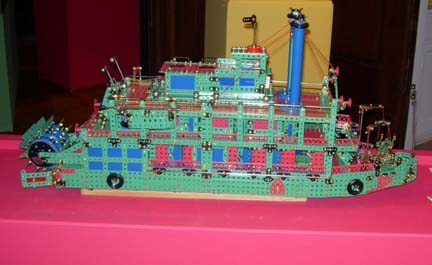- HOME
- VISIT
- ABOUT
- TOURS
- VISITOR FAQs
- LOCAL RESOURCES
- FAST FACTS
- MOAH HISTORY
- WILLIAMS HOUSE
- VICTORY GARDEN
- BOARD AND STAFF
- EXHIBITS
- CURRENT EXHIBIT
- PERMANENT EXHIBITS
- FUTURE EXHIBITS
- PAST EXHIBITS
- ARCHIVED EXHIBITS
- COLLECTION
- COLLECTION HISTORY
- DONATE TO THE COLLECTION
- SEARCH COLLECTION
- PROGRAMS & EVENTS
- CALENDAR
- ADULT PROGRAMS
- CHILDREN'S PROGRAMS
- ANNUAL EVENTS
- PAST EVENTS
- SPECIAL EVENTS
- GET INVOLVED
- MEMBERSHIP
- VOLUNTEER
- GIFT OPPORTUNITIES
- STAY CONNECTED
- EMAIL SIGNUP
- NEWSLETTERS
- PRESS
- Membership Response
The Paddlewheel Riverboat
As long as man has lived in America, rivers have served as transportation. Native Americans used canoes and log rafts; early white settlers added bateaus, flatboats and eventually keelboats. Movement downstream was easy; current carried passengers and cargo effortlessly. Going upstream created the challenge.By the beginning of the 19th century people began experiments with steam engines for marine power. In 1811, Robert Fulton and Nicholas Roosevelt built the first steam-powered boat, large enough for commercial use on the Ohio and Mississippi Rivers. No one knows what it looked like, for no drawings exist today. However, it proved that a steam-powered paddlewheel boat could be used on inland rivers.
Henry Shreve, a brilliant keelboat man, was the first to build truly a successful paddlewheel riverboat of sufficient size to be profitable, yet able to negotiate shallow rivers. His design became a standard for the Western rivers, and he is credited with launching the modern inland river transportation system.
Marklin No. 1082 Mississippi River Boat
 This operating model was built from a Marklin promotional assembly kit made only in 1992 in limited quantity. It is not a scale model, but represents a typical American stern wheel riverboat. Features include powered paddle wheel with prototypical connecting rod action, two working gangways, moveable rudders, 18 cabin doors that can be opened and closed and two life boats that can be lowered. The model contains some 5,409 parts (including nuts, bolts and washers). It is about 47" long and weighs 35 lbs.
This operating model was built from a Marklin promotional assembly kit made only in 1992 in limited quantity. It is not a scale model, but represents a typical American stern wheel riverboat. Features include powered paddle wheel with prototypical connecting rod action, two working gangways, moveable rudders, 18 cabin doors that can be opened and closed and two life boats that can be lowered. The model contains some 5,409 parts (including nuts, bolts and washers). It is about 47" long and weighs 35 lbs. This type of boat has served as an important mode of transportation on the nation's rivers, including the Sacramento, up through World War II. Today, boats like this still ply the major rivers carrying tourists, but they are mostly Diesel powered and have bow thrusters and non-functional paddlewheels.

This humble-looking Standard Vacuum Sweeper is the reason this Museum exists. In the early 1970s, accountant Frank Livermore spotted this sweeper in the corner of a local junk shop and, intrigued by its mechanical workings, Frank bought it on the spot. From that day on, he became a collector, and soon his Menlo Park home was bulging at the seams with his eclectic collection of antique mechanical and electrical devices.
Frank's friends joked that he should start a Museum of his own and, when one gave him a sign saying, Smithsonian West, Frank began to take the idea seriously. Frank and attorney Perry Moerdyke began the process of forming a registered non-profit Museum. In 1985 the Museum of American Heritage was incorporated. Frank's collection formed the nucleus of the Museum. In 1990 the Museum of American Heritage opened at its first location on Alma Street in Palo Alto and in 1997 MOAH was awarded tenancy of the City of Palo Alto's historic Williams House.
The Frank Livermore Trust was established to provide ongoing financial support for the care and maintenance of the collection.
Frank passed away in 2000, yet his curiosity and reverence for the spirit of innovation lives on in this Museum.
Today the collection boasts over 6,000 mechanical and electrical artifacts largely dating from the 1850s to the 1950s, which are housed in an offsite warehouse. Our artifacts are displayed in rotating exhibits at the Museum and are often loaned to other Museums and institutions for exhibit purposes.
Trademarks are the property of their owners
Join today! Membership dues help sustain MOAH. For more information and to download a Membership Form
LEARN MORE HERE
For questions and comments
Contact Us.
Mailing Address
PO Box 1731, Palo Alto, CA 94302
351 Homer Avenue
Palo Alto, California
p. 650.321.1004
e.




